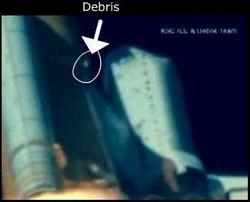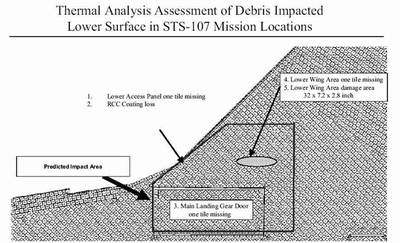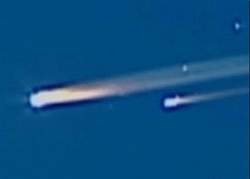STS-107 Debris Impacting Orbiter Wing
Preliminary Debris Transport Assessment of Debris Impacting Orbiter
Lower Surface in STS-107 Mission
January 21, 2003
In a report prepared by Boeing Aerospace on the
impact of debris during launch, the contractor indicated there was
indeed cause for concern. The summary, below, indicates engineers
really had no idea of the exact nature of the damage caused when
insulating foam impacted the underside of the orbiter's left wing.
They were forced to hypothesize.
Debris Impacts Orbiter Lower Surface
 • Issue
• Issue
– At about 82 seconds into the flight, a large piece of
debris was seen emanating from the ET bipod area and later seen
impacting the Orbiter lower surface tiles
• Background
– Preliminary assessment of debris impact conditions
predicted an impact to the Orbiter lower
surface at location XO1049, YO185 (results provided on January 17,
2003)
• Impact Velocity estimated to be 750 ft/sec.
• Impact Angle estimated to be less than 20 degrees
– Refinement of the results show reduction of impact angle
and impact velocity
– Analysis methodology and results were presented to the
Aero Panel on January 21, 2003
• Aero Panel concurrence was obtained
• Aero Panel recommended sending results to Orbiter Program
for damage assessment
Debris Impact Conditions to Be Evaluated for Area on Orbiter
Lower Surface
 • Actions Taken
• Actions Taken
– Defined impacts area based on film observations and
debris trajectory modeling
• Large uncertainty in trajectory computation does not
allow a good prediction of the
impact area
– Performed debris trajectory computations to define
impact conditions inside impact area.
• Debris particle emanates from bipod ramp area (XO 389, YO
50)
• Two debris sizes analyzed:
– 20” x 10” x 6” (representing flange
foam)
– 20” x 16” x 6” (representing bipod
ramp)
• Debris material considered to be foam (density = 2.4
lb/ft3)
• Particle subjected to initial lateral motion to simulate
lateral loading of bipod ramp
– Impact conditions inside predicted impact area was
derived as follows:
• Actual Impacts: Particle impact information as computed
by the debris trajectory
program
• Near Impacts: Particle velocity obtained for specific
points in particle trajectory
• Debris Database: to define particle impact angles at
locations in the landing gear wheel
well

Results Show Low Impact Angles on the Orbiter Lower
Surface
• Results -
– Completed evaluating results for trajectory analysis of
foam debris of size = 20”x10”x6”
• Impact velocity inside predicted impact area range
between 650 and 730 ft/sec.
– Impact velocity at wing RCC may vary between 700 and 720
ft/sec.
– Impact velocity at Landing wheel well varies between 650
and 730 ft/sec.
• Impact angles can be expected to be larger near wing
leading edges because of wing
curvature
– RCC impacts can be as high as 22 degrees in some
regions
• Impact angles at the landing wheel well are expected to
be less than 10 degrees
– Results for trajectory analysis of foam debris of size =
20”x16”x6” are currently under
evaluation
Summary and Conclusion
 Impact
analysis (“Crater”) indicates potential for large TPS
damage
Impact
analysis (“Crater”) indicates potential for large TPS
damage
– Review of test data shows wide variation in impact
response
– RCC damage limited to coating based on soft SOFI
- Thermal analysis of wing with missing tile is in work
– Single tile missing shows local structural damage is
possible, but no burn through.
– Multiple tile missing analysis is on-going M/OD criteria
used to assess structural impacts of tile loss.
– Allows significant temperature exceedance, even some
burn
through
- Impact to vehicle turnaround possible, but maintains safe
return capability
Conclusion
-Contingent on multiple tile loss thermal analysis showing no
violation of M/OD criteria, safe return indicated even with
significant tile damage.
 Aero-News: Quote of the Day (05.09.24)
Aero-News: Quote of the Day (05.09.24) ANN's Daily Aero-Term (05.09.24): Hold Procedure
ANN's Daily Aero-Term (05.09.24): Hold Procedure ANN's Daily Aero-Linx (05.09.24)
ANN's Daily Aero-Linx (05.09.24) Airborne 05.03.24: Advanced Powerplant Solutions, PRA Runway Woes, Drone Racing
Airborne 05.03.24: Advanced Powerplant Solutions, PRA Runway Woes, Drone Racing Airborne-NextGen 05.07.24: AI-Piloted F-16, AgEagle, 1st 2 WorldView Sats
Airborne-NextGen 05.07.24: AI-Piloted F-16, AgEagle, 1st 2 WorldView Sats






